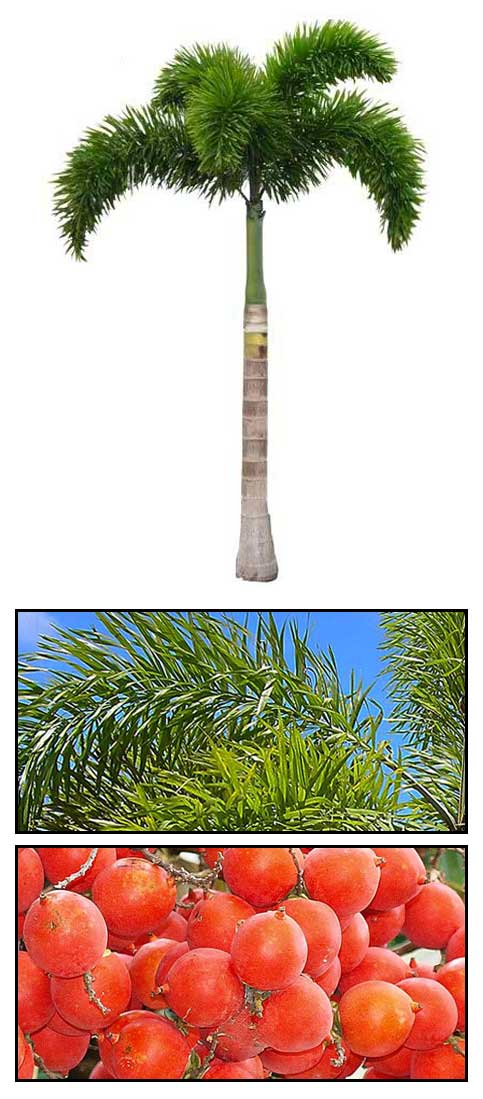 Gen info Gen info
- The palm was first introduced to the botanical world in 1983 when an Australian aboriginal man brought it to the world's attention.
- The species name Wodyetia bifurcata derives from (1) Wodyeti, the name of the Australian Aboriginal bushman, and (2) and the Latin word bifurcata, meaning twice forked, referring to the unique shape of the fruit and fish-tailed leaflets. (1)
- Wodyetia bifurcata is the sole species of the genus Wodyetia.
- Foxtail derives from the descriptive leaflets radiating out at all angles from the stems, akin to the tail of a fox.
- Species name "bifurcata" means "twice divided," alluding to the way the fibers within the fruit are arranged.
Botany
Wodyetia bifurcata is a recent introduction to the world of palms—a fast growing, large-sized evergreen tree, growing up to 10 meters tall. Pale green arching fronds have leaflets radiating out at all angles from the stems. A mature palm has a canopy of 8 to 10 leaves, each with the characteristic foxtail or bottle-brush appearance, with a crown of foliate 4.6 to 6.1 meters across. Trunk is slender, closely ringed bottle shaped to columnar, growing to a height of 9.1 meters. Fruits occur in colorful clusters of red to orange-red, each containing one seed, brown-black in color, up to 3-4 centimeters. (1)
Distribution
- Introduced.
- Ornamental cultivation.
- Native to a small part of Australia.
Constituents
- Aerial parts yielded the presence of ß-amyrin, lupeol, apigenin, kaempferol, p-hydroxyl benzoic acid and gallic acid. (see study below) (2)
- GLC analysis for fatty acid esters yielded six components, namely: Dodecanoic acid (Lauric acid) 11.12%, tetradecanoic acid (Myristic acid) 1.57%, hexadecanoic acid (Palmitic acid) 15.93%, octadecanoic acid (Stearic acid) 1.43%, cis-9-octadecanoic acid (Oleic acid) 16.92%, cis,cis-9,12-octadecanoic acid (Linoleic acid) 5.044%, All cis9,12,15-octadecanoic acid (Linolenic acid) 1.16%, 5,8,11,14-all-cis-eicosatetraenoic acid (Arachidonic acid) 1.96%. (3)
- Fatty acid analysis of aerial parts of W. bifurcata unsaponifiable fraction yielded pentadecane (1). hexadecane (2), heptadecane (3),
octadecane (4), nonadecane (5), eicosane (6), heneicosane (7), docosane (8), tricosane (9), tetracosane (10). pentcosane (11), hexacosane (12), cholesterol (13), campesterol (14), stigmasterol (15), and ß-sitosterol (16). (see study below) (3)
Uses
Edibility
- Blogs have reported the nectarine flesh of the fruit to be edible, although rather flavorless—not sweet, but slightly acrid.
- Caution: A blog by a veterinarian reported possible toxicity of fruit to a dog. However, the possibility of the fruit being a cicad was raised. (6)
Folkloric
- No reported folkloric medicinal use in the Philippines.
Others
- Beads: Seeds used for making Bodhi beads.
Studies
• Triterpenoid and Phenolic Content / Cytotoxicity: Study showed butanol extracts demonstrated weak cytotoxicity against HepG2 cells, with IC50 of 568.5 µg/ml. (see constituents above) (2)
• Fatty Acid Composition / Oleic Acid: Study of fatty acid composition showed major monounsaturated fatty acid is cis-9-octadecanoic acid (oleic acid) and the main saturated fatty acid was hexadecanoic acid (palmitic acid). Oleic acid has been reported as anti-inflammatory by influencing arachidonic acid metabolism together with a role in the activation of different pathways of immune competent cells, and antiatherogenic effects via lowering of total and LDL cholesterol, decreasing coronary risk factors of hypertension, diabetes and obesity. (see constituents above) (3)
• Endocarp Biochar for Removal of Methylene Blue: The endocarp of Wodyetia bifurcata was used to produce biochar by vacuum pyrolysis as an alternative adsorbent for methylene blue (MB) removal from aqueous solutions. (5)
Availability
- Cultivated as ornamental.
- Plants and seeds in the cybermarket.
|

![]()



 Gen info
Gen info